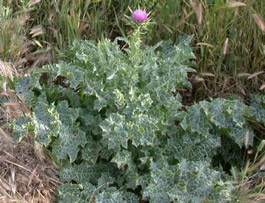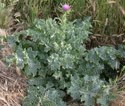Milk Thistle
Silybum marianum • Class A |
||
| Family Name: | Asteraceae family (ass-ter-AY-see-ee) | |
| Common: | Aster, daisy, or sunflower family | |
| Genus: |
Silybum (SIGH-lee-bum) Meaning: The Greek name for some edible thistles |
|
| Species: |
marianum (mar-ee-AH-num) Meaning: Of St. Mary |
|
| Description: |
This sparsely branched thistle grows up to 6 feet tall. Leaves are dark green with distinctive white veins on them and are about 10 inches wide and 20 inches long, with bases that clasp the stem. The wavy leaf margins are edged in yellow prickles that are roughly half an inch in length. Its leathery thorn tipped bracts at the base of each solitary purple flower head, make it unique from other thistles. It blooms from April to August. |
| Why Is it a Noxious Weed? |
Milk Thistle aggressively invades and crowds out desirable vegetation. Individual plants are so large that forage displacement is high. This weed is a nitrate accumulator. Ingestion of milk thistle by grazing animals causes nitrate poisoning, which can be lethal to cattle or sheep.
|
| Where Does it Grow? |
It is found along roadsides, waste areas. Pastures and fertile lands are invaded from roadside populations, ditches and disturbed areas. It is a prolific seeder and forms dense stands of thistle crowding out other beneficial plants. |
| Facts: |
Do not plant Milk Thistle intentionally. While Milk Thistle does have beneficial medicinal properties, the extract is very difficult to process. It takes about 70 pounds of seeds to produce one pound of extract purified to 70-80% silymarin (of which 60% is silybin, the most active and beneficial component). In this form, it is still difficult for the body to utilize, requiring huge quantities which are not feasible for home production. |
| Control Options: |
|
| More Information: |
Download our Flyer or visit Washington State Noxious Weed Control Board Here. Photo by Leo Michels
|
| More Pictures: |






 Pierce County Noxious Weed Control Board • 9200 122nd St E, Puyallup, WA 98373 • 253-798-7263
Pierce County Noxious Weed Control Board • 9200 122nd St E, Puyallup, WA 98373 • 253-798-7263